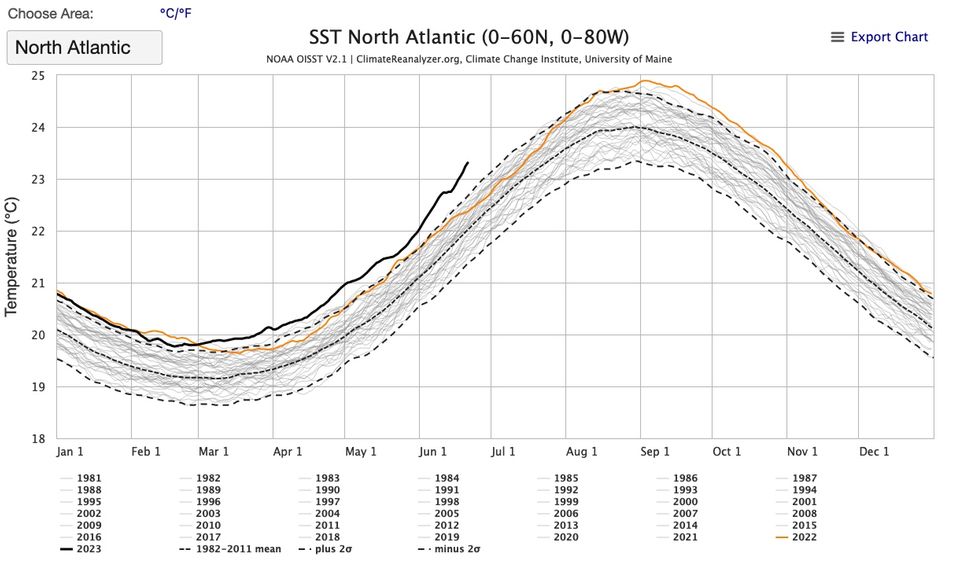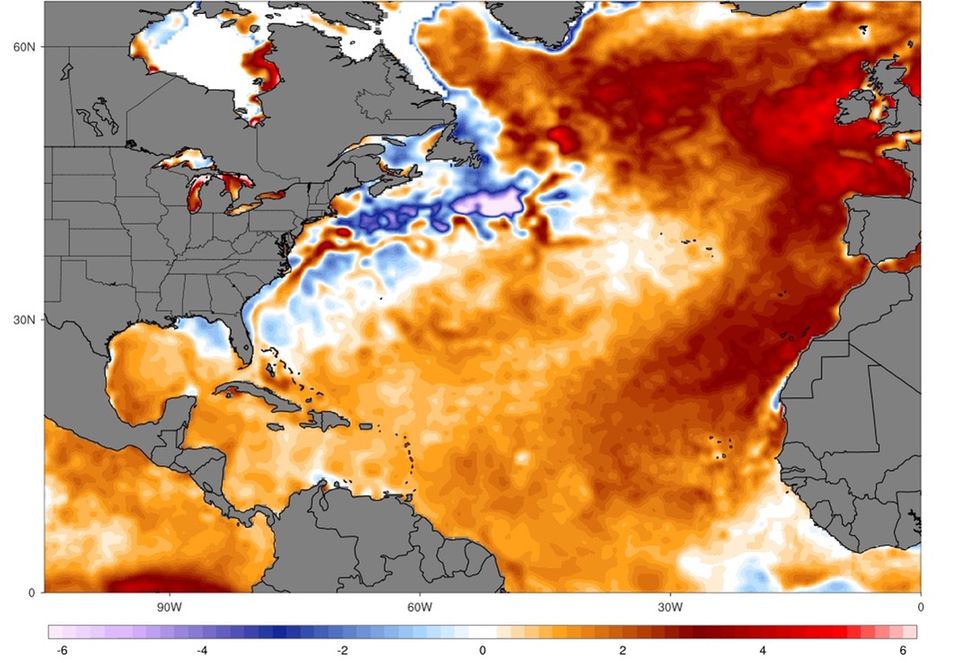Temperatures in the North Atlantic are beating all records. Sea heat could have devastating effects on life in the ocean, researchers warn. And the problem could continue for a few more months.
The black curve has been rising steadily since April, far outperforming all others: The graph from the University of Maine’s Climate Change Institute shows the daily sea surface temperature in the North Atlantic for the year 2023. On June 21, it was 23.3 degrees Celsius. The water temperature has thus set a record for this time of year. Last year it was 22.4 degrees.
The waters of the Atlantic around the British Isles have warmed particularly strongly. The Met Office, the UK’s national weather service, spoke of “record-breaking temperatures” currently prevailing in the North Atlantic in a statement earlier this week.

This graph from the University of Maine’s Climate Change Institute shows how sea surface temperatures in the North Atlantic have evolved over the years. The black curve shows the development for 2023.
© Climate Change Institute, University of Maine
“May 2023 was the hottest May since 1850. But that’s not all. It was also the highest month above average compared to any single month in the series,” said Professor Stephen Belcher, Met Office Principal Investigator.
Temperature increases of up to eight degrees
According to Belcher, the eastern Atlantic from Iceland to the tropics is particularly affected. “But the areas around parts of north-west Europe, including parts of the UK, are among the areas with the highest sea surface temperatures relative to average.” According to data from the European Space Agency Esa, the sea surface temperature in the North Sea is five degrees above average – in the Baltic Sea it is sometimes eight degrees.
Richard Unsworth, associate professor of life sciences at the University of Swansea in the UK, described the Atlantic heatwave as “completely unprecedented”. “It far exceeds the worst predictions for climate change in the region. It’s really frightening how quickly this sea basin is changing,” he told US broadcaster CNN.

This graph from the University of Maine’s Climate Change Institute shows where temperatures in the North Atlantic are higher or lower than average
© Climate Change Institute, University of Maine
The Met Office cites a combination of human-caused climate change and natural variability in the climate system as the reason for this temperature anomaly. “Climate change (…) continues to warm the surface of the planet, both on land and at sea. However, natural variations – including the warming and cooling phases of El Niño and La Niña respectively – result in small deviations from the global baseline temperature, which are due to of climate change as a whole.”
Several factors contribute to warming
‘Typically, dust from the Sahara helps cool this region by blocking and reflecting some of the sun’s energy,’ explained Professor Albert Klein Tank of the Met Office. “But weaker than average winds have reduced the amount of dust in the region’s atmosphere, which could result in higher temperatures.” Weaker trade winds could also play a role.
All of this is part of the natural fluctuations in the climate system. “These factors are not expected to represent a climate change-induced tipping point leading to a burst in temperatures. However, they will contribute to the climate and weather impact this year,” Klein Tank said.
Dillon Amaya of the National Oceanic and Atmospheric Administration (NOAA) in the USA cites changes in the atmospheric circulation as the main cause of temperature fluctuations in the ocean. This was “rather sluggish” in the North Atlantic. There is usually a subtropical high pressure system over the area, which determines the surface winds in this region. As those winds weaken, ocean temperatures tend to warm, Amaya said.
Plants and animals threatened by heat wave in the Atlantic
Other researchers suspect that a change in regulations about the sulfur content of marine fuels could also have contributed to the increase in warming. In 2020, the International Maritime Organization lowered the upper limit for sulfur content from 3.5 to 0.5 percent, writes the Los Angeles Times. This should improve the air in ports and coastal areas.
But sulfate aerosols can reflect sunlight away from Earth, contributing to the darkening of the Earth’s surface, the scientists explain.
The rise in sea surface temperature in the North Atlantic has several impacts that could be devastating, researchers say. For example, the Met Office predicts that the number of tropical storms and cyclones in the North Atlantic will be above average this year.
climate change
Forest fires, drought, floods: where extreme weather will already be everywhere in 2023
The heat wave could also pose a major threat to wildlife, says bioscientist Unsworth. “It is very likely that animals such as oysters, plants and algae will be killed by this European heatwave at sea, especially in shallow waters where temperatures can rise above background levels.”
Researcher: Oceans could still be warm into November
Warmer oceans are also causing coral reef bleaching and have been linked to toxic algal blooms that can deprive the water of oxygen and suffocate sea life. This would also affect the food security of many people.
Warmer water also absorbs less carbon, leaving more of it in the atmosphere. This in turn accelerates global warming.
In addition, the water expands due to warming, which leads to a rise in sea level, which is already rising due to the melting of the ice in the Arctic and Antarctic.
According to NOAA scientists, the current heat wave in the North Atlantic will not be over anytime soon. It could last into autumn, maybe even into November. The return of the natural El Niño climate pattern reinforces this fear – for large parts of the world’s oceans.
Sources: University of Maine Climate Change Institute, Met Office, Esa, CNN, “Los Angeles Times”, “The Guardians”, NBC

